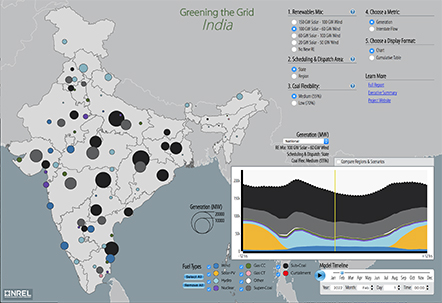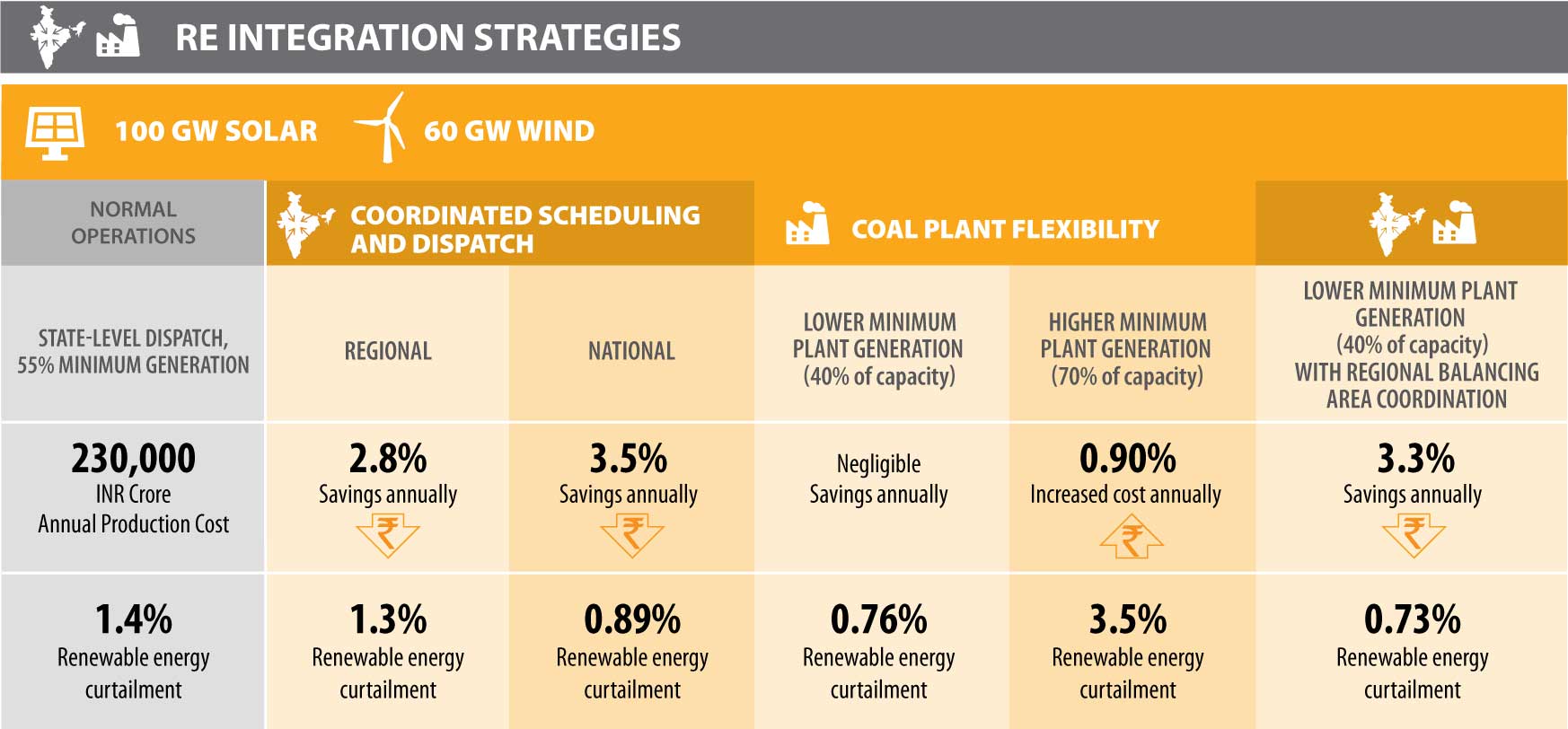India
Skip to:
India Renewable Integration Study
An NREL grid integration study has confirmed the technical and economic viability of integrating 175 gigawatts (GW) of renewable energy into India's electricity grid by 2022.

The visualization of results shows a full year of generation and transmission flows.
The two-volume report Greening the Grid: Pathways To Integrate 175 Gigawatts of Renewable Energy into India's Electric Grid Vol. I—National Study and Vol. II—Regional Study resolves many questions about how India's electricity grid can manage the variability and uncertainty of India's 2022 renewable energy (RE) target of 175 GW of installed capacity, including 100 GW of solar and 60 GW of wind, up from 9 GW of solar and 29 GW of wind installed in early 2017.
Using advanced weather and power system modeling, the study explored operational impacts of meeting India's 2022 targets and identified actions that are favorable for integration.
The National Study used a state-of-the-art production cost model, which simulates optimal scheduling and dispatch of available generation by minimizing total production costs subject to physical, operational, and market constraints. The objective was to simulate the scheduling and dispatch decisions that are based on variable or production costs. We developed this model to identify how the Indian power system is balanced every 15 minutes in a future year (2022). The model quantifies RE generation, including variability and curtailment, changes in least-cost scheduling and dispatch, flexibility of thermal generation, and periods of stress. To investigate system operations in each of the states with the potential for significant growth in RE capacity, the study team also used a higher-resolution regional model that includes intrastate transmission details. This model—the focus of Vol. II—builds upon the same inputs in the national model but with increased transmission detail within each of the states in the Southern and Western regions plus Rajasthan. Therefore, the regional model provides more robust views of localized operations and can offer more relevant insights to support state-level planning.
The results demonstrate that power system balancing with 100 GW solar and 60 GW wind is achievable at 15-minute operational timescales with minimal RE curtailment. India's current coal-dominated power system has the inherent flexibility to accommodate the variability associated with the targeted RE capacities, and coal flexibility in low-RE, coal-dominant states can play an important role in facilitating RE integration nationwide.
The study results reveal operational impacts, such as:
- The 160 GW of solar and wind capacity can serve 22% of India's power demand, providing benefits of fuel savings and reduced emissions.
- The power system as planned for 2022 is able to manage the added variability of wind and solar; new, fast-ramping infrastructure (such as natural gas turbines) is not necessary to maintain balance.
- In a system with 160 GW of wind and solar, coal plants, on average, operate at only half their capacity, suggesting the potential role for a new tariff structure that moves away from focusing on energy delivery and instead compensates plants for performance that achieves flexibility goals.
The study also evaluates the value of strategies to better integrate RE and demonstrates the importance of policy and market planning. The results of the study indicate that:
- National and regional coordination of scheduling and dispatch eases renewable energy integration and results in cost savings by smoothing variability and broadening the supply of system flexibility.
- Flexibility of India's coal fleet is critical to minimizing curtailment of renewable energy.

The visualization of results includes the study's full year of generation and transmission flows for multiple RE integration strategies. These visualizations show the state-level balancing of generation and load and for every 15-minute period of 2022.
This work is conducted under a broader program, Greening the Grid, which is an initiative co-led by India's Ministry of Power and the U.S. Agency for International Development, and includes co-sponsorship from the 21st Century Power Partnership and the World Bank's Energy Sector Management Assistance Program. The modeling team comprised a core group from the Power System Operation Corporation Limited, which is the national grid operator (with representation from the National, Southern, and Western Regional Load Dispatch Centers), National Renewable Energy Laboratory, and Lawrence Berkeley National Laboratory, and a broader modeling team drawn from Central Electricity Authority, POWERGRID (the central transmission utility), and state load dispatch centers in Maharashtra, Gujarat, Rajasthan, Tamil Nadu, Karnataka, and Andhra Pradesh. Technical stakeholder review was provided by three teams of Grid Integration Review Committees consisting of more than 150 power system stakeholders from across India.
South Asia Regional Connectivity
- NREL conducted an analysis of the technical and economic potential of a high-voltage DC (HVDC) tie between India and Sri Lanka. Publication forthcoming.
- Another study assessed the market and regulatory barriers to increased trade between India and Nepal. Publication forthcoming.
Expansion Planning
NREL is collaborating with the Central Electricity Authority (CEA) in India to develop a national expansion planning tool (ReEDS India) based on state-of-the-art modeling techniques to capture relevant features of high RE power systems.
Preliminary results forthcoming in 2019.
Scaling Grid-Connected Distributed Energy
NREL is collaborating with power sector stakeholders in Gujarat and Jharkhand through USAID’s Partnership to Advance Clean Energy Deployment (PACE -D 2.0 RE) program to scale the deployment of distributed energy resources. Activities include:
- Exploring regulatory frameworks for DPV+storage. See An Overview of Behind-the-Meter Solar-Plus-Storage Program Design: With Considerations for India.
- Identifying key DPV quality and safety challenges and solutions:
- Fact Sheet: Rooftop Solar PV Quality and Safety in Developing Countries — Key Issues and Potential Solutions
- Report: Distributed Solar Quality and Safety in India: Key Challenges and Potential Solutions
- Understanding the value of distributed solar to distribution utilities and how it can inform new compensation models for DPV.
Power plant map


